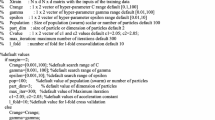Abstract
It is known that Support Vector Domain Description (SVDD) has been introduced to detect novel data or outliers. The key problem of training a SVDD is equivalent to solving constrained quadratic programming problem. The Linear Particle Swarm Optimization (LPSO) is developed to optimize linear constrained functions, which is intuitive and simple to implement. However, premature convergence would be followed with the LPSO. The LPSO is extended to the Converging Liner PSO (CLPSO), which is always guaranteed to find at least a local optimum. A new method using CLPSO to train SVDD was proposed. Experimental results demonstrated that the proposed method was feasible and effective for SVDD training, and the performance of it was better than that of traditional method.



Similar content being viewed by others
References
Vapnik VN (2000) The nature of statistical learning theory, 2nd edn. Springer, New York
Cortes C, Vapnik V (1995) Support-vector networks. Mach Learn 20(3):273–297
Hsu CW, Lin CJ (2002) A comparison of methods for multi-class support vector machines. IEEE Trans Neural Netw 2(13):415–425
Zhou HY, Miller P, Zhang JG (2011) Age classification using Radon transform and entropy based scaling SVM. In: Proceedings of British machine vision conference, Dundee, UK, pp 1–12
Chi XJ, Dong JY, Liu AH, et al. (2006) A simple method for Chinese license plate recognition based on support vector machine. In: Proceedings of the 4th international conference on communications, circuits and systems, pp 2141–2145
Collins M, Zhang JG, Miller P, et al. (2010) EigenBody: analysis of body shape for gender from noisy images. In: International machine vision and image processing conference, 2010
David MJT, Robert PWD (2004) Support vector data description. Mach Learn 54(1):45–66
Vapnik VN, Kotz S (2006) Estimation of dependences based on empirical data. Springer, New York
Osuna E, Freund R, Girosi F (1997) Training support vector machines: an application to face detection. Published by the IEEE Computer Society
Osuna E, Freund R, Girosi F (1997) An improved training algorithm for support vector machines. Citeseer 276–285
Platt JC (1998) Fast training of support vector machines using sequential minimal optimization. In: Schölkopf B, Burges CJC, Smola AJ (eds) Advances in Kernel methods—support vector learning. MIT Press, Boston, pp 185–208
Kennedy J, Eberhart R (1995) Particle swarm optimization. In: IEEE international conference on neural networks, pp 1942–1948
Yuan H, Zhang Y, Zhang D, et al. (2006) A modified particle swarm optimization algorithm for support vector machine training. In: The sixth world congress on intelligent control and automation, pp 4128–4132
Paquet U, Engelbrecht AP (2003) A new particle swarm optimiser for linearly constrained optimization. In: The 2003 congress on evolutionary computation, vol 1, pp 227–233
Paquet U, Engelbrecht AP (2003) Training support vector machines with particle swarms. In: Proceedings of the international joint conference on neural networks, vol 2, pp 1593–1598
Paquet U, Engelbrecht AP (2007) Particle swarms for linearly constrained optimisation. Fund Inform 76(1):147–170
van den Bergh F, Engelbrecht AP (2002) A new locally convergent particle swarm optimizer. In: IEEE international conference on systems, man and cybernetics, vol 3, pp 6–11
Angeline P (1998) Evolutionary optimization versus particle swarm optimization: philosophy and performance differences. Evol Program VII:601–610
Shi Y, Eberhart R (1998) Parameter selection in particle swarm optimization. Evol Program VII:591–600
Eberhart RC, Shi Y (2000) Comparing inertia weights and constriction factors in particle swarm optimization. In: Proceedings of the 2000 congress on evolutionary computation, vol 1, pp 84–88
Acknowledgments
This work is supported by National Natural Science Foundation of China (60872070, 61171152), Science and Technology Plan of Zhejiang Province (2010C33044) and Major Scientific and Technological Project of Zhejiang Province (2010C11069).
Author information
Authors and Affiliations
Corresponding author
Rights and permissions
About this article
Cite this article
Wang, H., Zhao, G. & Li, N. Training support vector data descriptors using converging linear particle swarm optimization. Neural Comput & Applic 21, 1099–1105 (2012). https://doi.org/10.1007/s00521-012-0872-y
Received:
Accepted:
Published:
Issue Date:
DOI: https://doi.org/10.1007/s00521-012-0872-y




